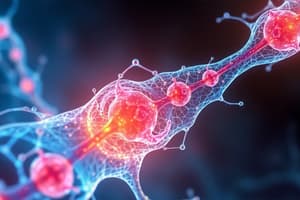Podcast
Questions and Answers
How does connective tissue differ from the other three major tissue types?
How does connective tissue differ from the other three major tissue types?
Connective tissue often consists of relatively few cells embedded in an extracellular matrix.
Which of these describes loose connective tissue?
Which of these describes loose connective tissue?
It is a loose weave of fibers that functions as a packing material.
Cartilage is found _____.
Cartilage is found _____.
at the ends of bones such as the femur.
_____ is the connective tissue specialized for transport.
_____ is the connective tissue specialized for transport.
What type of epithelium would you expect to find covering a surface subject to physical forces?
What type of epithelium would you expect to find covering a surface subject to physical forces?
What type of epithelial tissue, found in the intestines, absorbs nutrients?
What type of epithelial tissue, found in the intestines, absorbs nutrients?
Which of these tissues, found in the lungs, permits gas exchange by diffusion?
Which of these tissues, found in the lungs, permits gas exchange by diffusion?
What type of epithelial tissue lines kidney tubules?
What type of epithelial tissue lines kidney tubules?
What type of muscle is responsible for contractions of the digestive tract and arteries?
What type of muscle is responsible for contractions of the digestive tract and arteries?
Cardiac muscle is the only muscle composed of _____ fibers.
Cardiac muscle is the only muscle composed of _____ fibers.
_____ muscle is attached to bones.
_____ muscle is attached to bones.
A neuron consists of _____.
A neuron consists of _____.
Nervous tissue functions ____.
Nervous tissue functions ____.
Which of the following is a correct statement about an organism and its environment?
Which of the following is a correct statement about an organism and its environment?
The four major categories of tissues are _____.
The four major categories of tissues are _____.
Penguins, seals, and tuna have body forms that permit rapid swimming, because
Penguins, seals, and tuna have body forms that permit rapid swimming, because
As body size increases in animals,
As body size increases in animals,
Most of the exchange surfaces of multicellular animals are lined with
Most of the exchange surfaces of multicellular animals are lined with
An example of a connective tissue is the
An example of a connective tissue is the
Stratified cuboidal epithelium is composed of
Stratified cuboidal epithelium is composed of
Connective tissues typically have
Connective tissues typically have
The nourishment, insulation, and support for neurons is the result of activity by the
The nourishment, insulation, and support for neurons is the result of activity by the
Fibroblasts secrete
Fibroblasts secrete
Blood is best classified as connective tissue because
Blood is best classified as connective tissue because
Muscles are joined to bones by
Muscles are joined to bones by
With its abundance of collagenous fibers, cartilage is an example of
With its abundance of collagenous fibers, cartilage is an example of
In a typical nerve cell, the nucleus is found in the
In a typical nerve cell, the nucleus is found in the
All types of muscle tissue have
All types of muscle tissue have
All skeletal muscle fibers are both
All skeletal muscle fibers are both
Food moves along the digestive tract as the result of contractions by
Food moves along the digestive tract as the result of contractions by
The type of muscle tissue surrounding internal organs, other than the heart, is
The type of muscle tissue surrounding internal organs, other than the heart, is
The body tissue that consists largely of material located outside of cells is
The body tissue that consists largely of material located outside of cells is
Flashcards are hidden until you start studying
Study Notes
Connective Tissue
- Connective tissue has relatively few cells integrated within an extensive extracellular matrix.
- Loose connective tissue serves as packing material with a loose weave of fibers.
- Cartilage is located at the ends of long bones, such as the femur.
- Blood is the connective tissue specialized for transport, containing cells separated by an extracellular matrix.
- Examples of connective tissue include blood and cartilage, characterized by collagenous fibers.
Epithelial Tissue
- Stratified epithelium covers surfaces subject to physical forces, providing protection.
- Simple columnar epithelium, found in the intestines, is specialized for nutrient absorption.
- Simple squamous epithelium, located in the lungs, allows for efficient gas exchange by diffusion.
- Simple cuboidal cells line kidney tubules, facilitating filtration and secretion.
- Stratified cuboidal epithelium consists of multiple layers of box-like cells.
Muscle Tissue
- Smooth muscle is responsible for involuntary contractions in the digestive tract and arteries.
- Cardiac muscle consists of branched fibers, distinct from other muscle types.
- Skeletal muscle is attached to bones and is both striated and under voluntary control.
- All muscle types involve interactions between actin and myosin filaments.
- Smooth muscle surrounds internal organs, excluding the heart.
Nervous Tissue
- Neurons are specialized cells that transmit electrical impulses; their structure includes a cell body housing the nucleus.
- Glial cells provide nourishment, insulation, and support to neurons, facilitating overall nervous system function.
General Tissue Functions and Relationships
- Four primary tissue categories: nervous, epithelial, connective, and muscle.
- As animal body size increases, the surface-to-volume ratio decreases, affecting physiological processes.
- Epithelial tissue lines most exchange surfaces in multicellular organisms.
- Interstitial fluid mediates exchanges between body cells and the circulatory system in vertebrates.
- Muscle contractions drive the movement of food through the digestive tract.
Studying That Suits You
Use AI to generate personalized quizzes and flashcards to suit your learning preferences.




